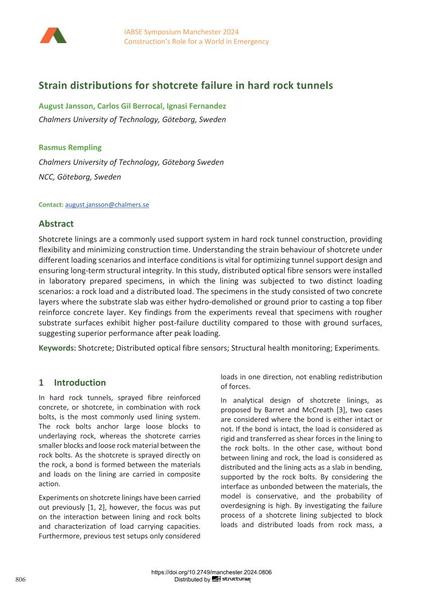Strain distributions for shotcrete failure in hard rock tunnels

|
|
|||||||||||
Bibliographic Details
| Author(s): |
August Jansson
(Chalmers University of Technology, Göteborg, Sweden)
Carlos Gil Berrocal (Chalmers University of Technology, Göteborg, Sweden) Ignasi Fernandez (Chalmers University of Technology, Göteborg, Sweden) Rasmus Rempling (Chalmers University of Technology, Göteborg Sweden NCC, Göteborg, Sweden) |
||||
|---|---|---|---|---|---|
| Medium: | conference paper | ||||
| Language(s): | English | ||||
| Conference: | IABSE Symposium: Construction’s Role for a World in Emergency, Manchester, United Kingdom, 10-14 April 2024 | ||||
| Published in: | IABSE Symposium Manchester 2024 | ||||
|
|||||
| Page(s): | 806-813 | ||||
| Total no. of pages: | 8 | ||||
| DOI: | 10.2749/manchester.2024.0806 | ||||
| Abstract: |
Shotcrete linings are a commonly used support system in hard rock tunnel construction, providing flexibility and minimizing construction time. Understanding the strain behaviour of shotcrete under different loading scenarios and interface conditions is vital for optimizing tunnel support design and ensuring long-term structural integrity. In this study, distributed optical fibre sensors were installed in laboratory prepared specimens, in which the lining was subjected to two distinct loading scenarios: a rock load and a distributed load. The specimens in the study consisted of two concrete layers where the substrate slab was either hydro-demolished or ground prior to casting a top fiber reinforce concrete layer. Key findings from the experiments reveal that specimens with rougher substrate surfaces exhibit higher post-failure ductility compared to those with ground surfaces, suggesting superior performance after peak loading. |
||||
| Keywords: |
shotcrete experiments structural health monitoring Distributed optical fibre sensors
|
||||
